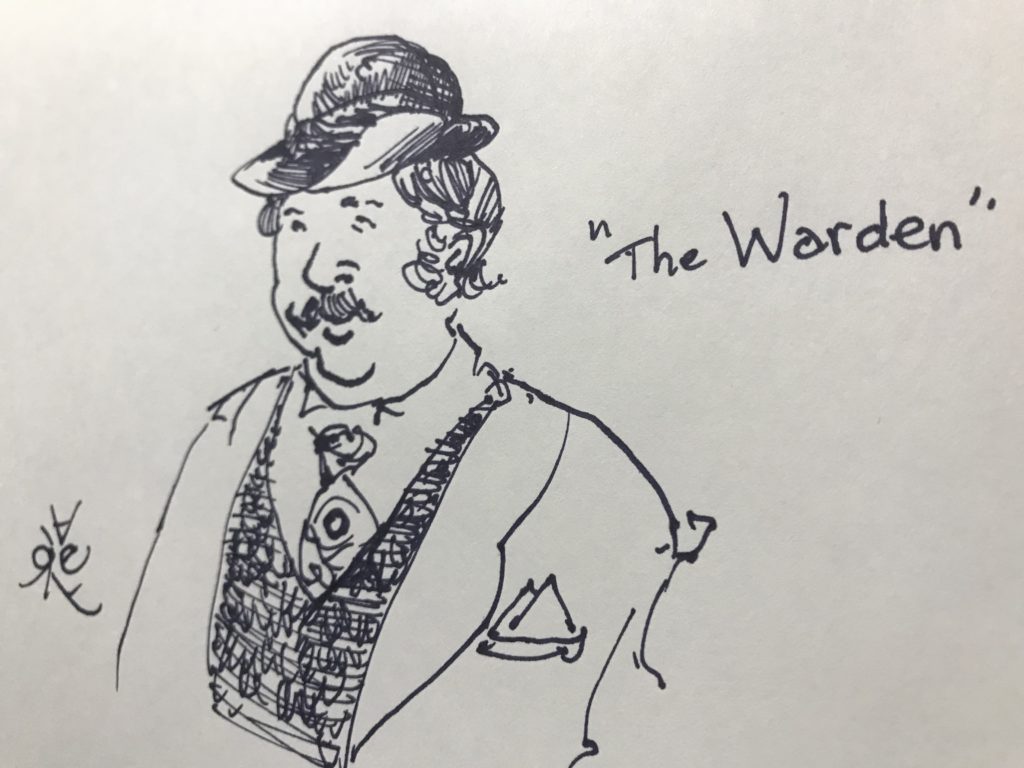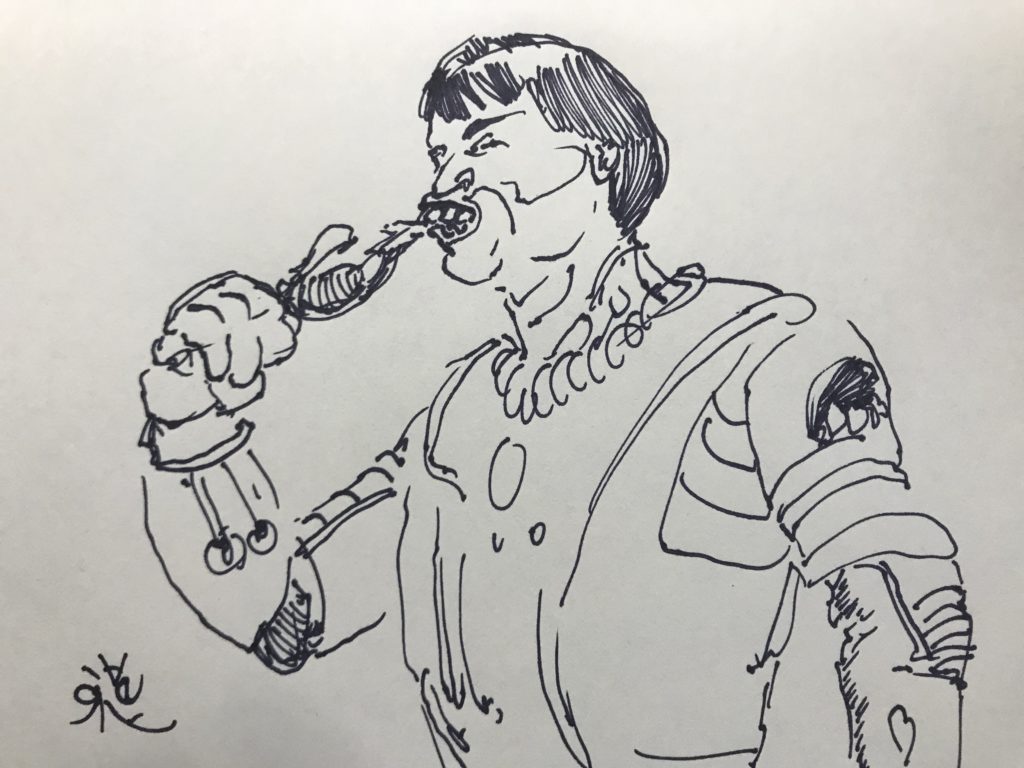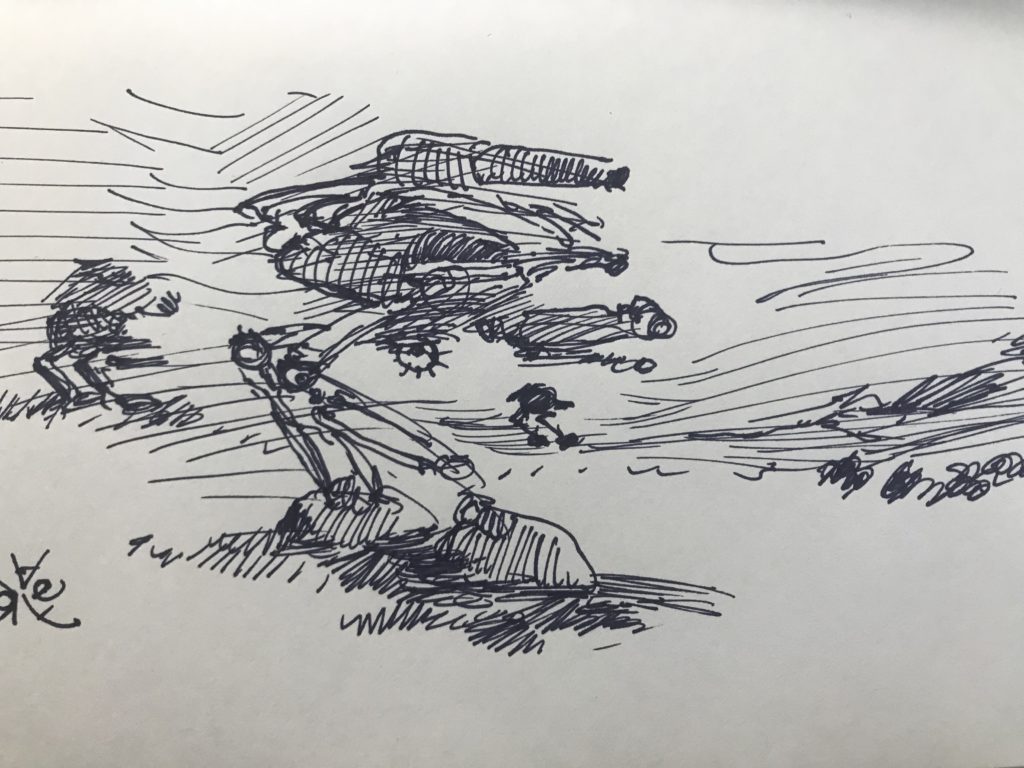Anthony Trollope’s Bittersweet Gem
by Rey ArmenterosThe Warden by Anthony Trollope was on a shelf in a used bookstore, years back when I was living in another country and not expecting to find such a thing. It was the only used bookstore I knew that had a small section for English books. I had been curious about Trollope, but I had all this other stuff to read and decided not to get it then. I might have thought about Trollope from time to time since then; he was one of those authors I felt I was going to read one day.
Then, I got into a shopping binge a few years back. I would go through cycles of themes and purchase everything I could that I felt was related to that theme. It started with art books. My collection of art books at the time was pathetic, and I was trying to remedy that. I did remedy it and went on to other things. I kid you not that every type of literature that could occur to me went through a reassessment, and I found that I had to own some of it, regardless if I had read it before or planned on reading it soon. I found The Warden online and bought it and two other Trollope books and stored them somewhere when the shipment came in. These were books filed away for future use.
I hardly ever thought about Trollope again, you see, because it was like owning something and concluding that you had taken care of that problem, even if you had never interacted with that thing that you were owning. Trollope came up again recently, and I had almost forgotten the original story that had splashed a spot of color on him as an author, giving him the one characteristic that I had happened to know of him.
I think every author of note has a one- or two-sentence biographical summary that places that person in their own light. With Trollope, it was the fact that he followed a daily regimen of writing so punctilious, he was almost a machine about it. He had a full-time job outside of writing and was only writing a set amount of time per day. When the time came to stop so that he could go to his place of employment, he would put down his pen, even if he were in mid-sentence.
Reading him now, after pocketing the first few chapters of The Warden into my realm of experience, I started to quickly conclude that he was indeed a 19th Century author, and I knew that I was expecting this. No surprise really. The story was set up with a thorough introduction in the first chapter of the setting for our little story, followed by a complete introduction of the main character and his relatives, acquaintances, and their relationships. The situation of a certain several hundred-year old will was then explained with some detail, because as we would soon learn, it was going to affect the state of affairs for our main character in his countryside concern.
If we were to look at it with contemporary eyes, this is the sort of opening that would prevent the casual reader from reading any further. But again, I was already expecting something like that. And as I predicted, the story develops in earnest afterward.
By the fifth chapter or so, I was under the impression that certain parts of this book needed some cleaning up, and it reminded me of that one characteristic about Trollope, the writer, that made me wonder if it weren’t for this characteristic that we were getting longer portions of narrative than were necessary. Trollope’s particularities were showing through, as I was observing it. His method of starting his writing at a certain time of the morning and then ceasing the very minute he was to get on with his actual employment seems like that type of quirk that might pique the interest of a public today, but it did nothing of the kind during his time. When his writing process was released to the world, he was criticized as the type of artist that does not work from inspiration. He was viewed as an automaton. How could the author of works feel any love for them if he was going to subject them to such a strict mode of operation?
In the light of his actual job with the postal department, he couldn’t have done it any other way. How could he have ever accomplished the career he had in writing otherwise? If working in the schedule of an automaton were the only way he could get his work done, the so be it. As an employee with a full-time responsibility, he had to do it that way if he was going to accomplish anything in writing!
But I was starting to see that following a tight schedule, and consequently following an impetus in your writing (only ever going forward) might have its drawbacks. If he picked up his pen at five in the morning and put it down in the middle of a progressing thought at 6:30, it tells me that he was writing all previous thoughts on the matter of his book without sudden reflection or change of mind. I have no doubt he edited his work afterward, but if he could have written without so much timed impetus, he might have paused a little more and maybe done away with some of the longer meanderings. I was not standing over his shoulder witnessing any of his scribbling adventures, and yet you can still feel that punctiliousness hanging over the written words that not even a dozen or a score of revisions could reshape.
So far, everything I have accused Trollope of comes from feelings and from knowing one or two things about him. It is another way of saying it comes from prejudice. If the prose in his book seems stiff to a latter-day ear, it is because of the times that he lived in more so than his characteristics as a person. But after I went past the halfway point of the book, I discovered that he was actually shaping his novel into a very precise narrative that had a series of actions that brought us to an inevitable conclusion. In fact, each action was a chapter. One chapter focuses on one thing. Contrary to my initial assumption, there is no added fat here. Regardless of how his narrative voice sounds to a 21st Century ear, each chapter in the book has a purpose. The chapter titles give a hint as to what that purpose is. Even if the writing is a little more verbose than I like it, the form of the book is elegant. When I recognized that, I found myself responding to this elegance as I was reading, and every time I put the book down, I reflected on this quality in his work, taking it in as one would any worthwhile work of art.
The chapters had titles that previewed the event of the chapter. There was no surprise as things were happening, but when the warden resigns, which is delineated as such in a later chapter titled, “The Warden Resigns,” I was reading this chapter wondering if the letter of resignation he wrote was ever going to make it to the bishop to finalize the matter. It was my way of forecasting changes to fate, giving the warden a chance to not resign on the technicality of a letter ever making it to its destination, even if the title gave away the results of actions, all along. And when I finished that chapter, I still thought there was a chance that the warden would keep his position.
That elegance formed ideas in my mind, inviting me to go back to the earlier parts of the book and finding the machinery behind the story, how everything in the plot was set in motion due to the inquiries of a close friend of the warden. Because of these inquiries, John Bold begins an investigation that questions if such a large portion of the monies distributed by the will should be going to fund the warden’s income.
After his inquiry is presented, which involved lawyers on both sides and every character in the book being affected by the machinery started by this, the impetus was unstoppable. Even when John Bold drew back the lawsuit, he couldn’t have erased the nasty newspaper articles written about his friend, the warden. And there was still the question of who was going to pay the fees for all these lawyers.
When the warden wishes to resign because he does not feel comfortable taking the money from the trustees of the will, he is impeded by his closest relations. Finally, the warden takes a trip to London and meets the Attorney General of England, and even the highest-appointed attorney in the land cannot answer his question: does the money that has been coming to warden from the will these past twelve years rightfully belongs to him or not? The attorney general admits that old wills such as the one linked to his hospital cannot make provisions for the changing times, and they were difficult to make progressive. It was telling the warden that there were no easy answers, and it was telling the readers that there were no real bad guys.
Of course, the warden’s son-in-law archdeacon was a type of antagonist to the warden, even if he were looking after the warden’s best interests, but doing so by bullying him into taking the actions the archdeacon felt were proper. But in such real life matters, the archdeacon really couldn’t be blamed. And Bold was only doing what he thought was right, even if it put a severe strain on his friendship with the warden. It was Bold’s initial action that made every action thereafter come to life, and through every step, through every chapter, there were motions to counter this impetus, but they either had no effect or just enough effect to give a contradictory result. And yet the book never reads as an exercise in frustration. It is more of a real look at a particular system of society tinged with a bit of sadness for the warden and the people closest to him, including John Bold himself.
All of my thoughts so far came from an unfinished reading of the book. I was not far from the end when I put them down to express these observations.
And now that I’ve finished it, I can look back at what I have said about it and see where I went wrong. Actually, I was right in thinking that everything came to pass because of that one action that John Bold commits close to the beginning of the book. And yet, I was wrong that the letter of resignation did not exactly amount to the resignation itself. When next we hear about it, the bishop has already accepted the resignation, and the wheels of change (for the life of the former warden) had been kicked into motion.
There is a Christian lesson at the end of it. The twelve men that were supporting the lawsuit against Mr. Harding (the warden) had assumed that since he was leaving, they would be getting a much larger sum in their yearly incomes. The view of the book was that these old men who did not have that many years left to live were getting rid of a friendship for the interest of money. Not only would they not be getting the money that allegedly belonged to them, they were no longer going to receive Mr. Harding’s small weekly allotment he was giving them when he was the warden. And they were now sad knowing that whoever took his place could not possibly be as kind as their former friend.
George Orwell held The Warden as a great achievement by Trollope, but he felt that though the archdeacon (Dr. Grantly) was to be held as the proper antagonist, that Trollope himself perhaps felt better about him than John Bold, who some could look at as a busybody, poking his nose into things that had nothing to do with him, all under the banner of righteousness.
I found that remark by Orwell when I was looking up this novel for something else that had drawn my attention. In one of the middle chapters, we learn of a novelist in the story who champions the poor and makes the well-placed and the rich look like the wicked leeches of society. Trollope takes up about a page or two to lambast this person, and I felt that he was targeting a real person. Immediately, I thought about Charles Dickens, and that is why I had to look it up. And I was right. Trollope’s sketch of Dickens was rendered with a very sharp file, and I thought that this was the conservative answer to someone who was looking for reform. Perhaps to our eyes, Dickens won that war a long time ago, since to the modern mind, we deplore the working conditions that used to be common in the factories and mines of old. I don’t know what Orwell’s opinion was about it (though I guess he sides with Dickens too). The Warden might be a critique of those Dickensian parts, and you can take whatever side you think is right.
But The Warden gave me a small gift as well. It is one of those moments in a book when something happens that you can’t stop thinking about. It is an unforgettable image of the warden performing for an audience of one. This warden, who so loved music and lived his life in the service of music, would sometimes play his cello in his imagination when it was not around to actually play. He would put his hands behind his back or under a table and draw the bow across the strings as if he were really playing while in conversation with someone that had no idea what he was doing. When he meets the all-important Attorney General of England to find out if he were entitled to the will’s money or not, the attorney general explains to him, after admitting that there is no answer to his question for such an old will, that the warden should no longer question the money because it was his to take by law. And he added that if he didn’t take the income, on what could he possibly live? Without the income, the warden would have to fall back on very limited means. And the warden, who had been playing his cello behind his back while he was coming up with his retort to the attorney general, brings it out and plays this imaginary instrument in front of this personage as he is explaining to him that he could no longer take the money and would need to resign, because his conscience could not allow it any other way, no matter how difficult it would make his life thereafter. The attorney general, who had had a long day as is typical for someone in that position, was struck dumb and wondered if the warden were losing his mind. But the warden himself was aware of what he was doing, and he recognized that this was his shining moment, playing his big performance that he was not going to regret no matter what life would have in store because of his decision.


